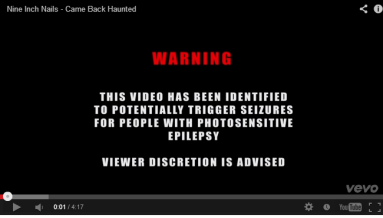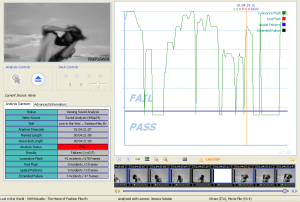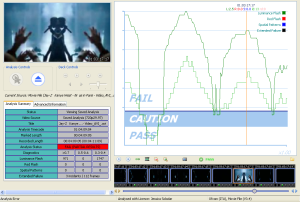41 percent of Kanye’s videos can make you seize
Posted: 09/08/2015 Filed under: Music Videos, Results of safety testing | Tags: epilepsy advocacy, flash, flicker, Kanye West, music videos, photosensitive epilepsy, seizures Leave a comment
Kanye West accepts the Video Vanguard Award during the 2015 MTV Video Music Awards on August 30 in Los Angeles. (Photo by Kevin Winter/MTV1415/Getty Images For MTV)
Because Kanye West received the Michael Jackson Video Vanguard Award at last weekend’s 2015 MTV Video Music Awards, and because there were seizure risks found with some of his videos, I wanted to know how many of his music videos pose that risk. I wrote previously about a couple of his videos— All of the Lights (2011), and Lost in the World (2012)—that contain seizure-inducing images. Another one I wrote about for its seizure-inducing content, N**as in Paris (2012), was made with Jay-Z.
So in the week since Kanye was recognized for his achievement in music videos, I’ve tested as many of his music videos as I could—46—to determine how many contain flashing/moving image sequences capable of triggering seizures in sensitive individuals. My sample included only videos where Kanye is the primary performer, where he would have had artistic control over the visuals. I didn’t include those made jointly with Jay-Z or if Kanye was a featured guest on a video made by other artists.
41 percent of Kanye’s videos —that’s 19 of 46—could give you a seizure if you are vulnerable to visually induced seizures. OK, but has he stopped releasing videos that can bring on seizures? Did Kanye change his production style after UK-based Epilepsy Action called out the problem videos a few years back? Nope. The two videos I tested from 2015 both failed the seizure guidelines image analysis test.
Here are the results from the Harding Flash and Pattern Analyzer, a tool designed to detect video images that can trigger seizures in people with photosensitive epilepsy. Ironically, the video titled “Flashing Lights” passed the Harding test.
“Throughout his career, West has blended musical and visual artistry to powerful effect.” — press release announcing the Video Vanguard Award.
David Lynch music video: 70 violations of guidelines for reducing seizures
Posted: 07/05/2013 Filed under: Music Videos, Photosensitive Seizure Prevention, Results of safety testing | Tags: David Lynch, flash, flicker, Kanye West, music videos, photosensitive epilepsy, photosensitivity, seizure warning, Twilight: Breaking Dawn 4 Comments
This warning is shown briefly before the video begins showing an onslaught of flashing images. This is just a screen shot, not the video itself.
David Lynch’s just-released music video for Nine Inch Nails’ “Came Back Haunted” provides more than 4 minutes of nearly constant seizure-provoking flashes and images. When analyzed for seizure safety, the video fails in 70 instances to adhere to international safety guidelines for flash, including the intermittent use of saturated red images.
Before the barrage of flashes begins, the official release on the Vevo music video website is accompanied by the following message: “WARNING: This video has been identified by Epilepsy Action to potentially trigger seizures for people with photosensitive epilepsy. Viewer discretion is advised.”
Two very big problems with this:
1. There’s a disturbing, no doubt intentional, consequence of highlighting the risk of seizures. Emphasizing that viewers are flirting with danger seems to be a marketing move. Unfortunately, this tactic does attract attention, but it trivializes the actual health risks.
2. Contrary to the claim that the UK Epilepsy Action organization determined that there was a photosensitive seizure risk in the video, Epilepsy Action’s website states that the organization was not consulted about the video. The organization is investigating and plans to continue reporting on it. A news item on the website quite correctly states, “It appears conscientious to show a warning before the video. However, many people with photosensitive epilepsy do not know they have it until something like this triggers their first seizure.” If filmmaker Lynch is conscientious, why not remove the seizure risk in the first place?
Trivializing seizures by using them for marketing
Here’s what happens when the seizure risk is used for marketing purposes. People who know nothing about epilepsy are charmed by the video’s association with seizures and use it to spice up their commentary:
- “David Lynch and Trent Reznor Make Seizure-Inducing Magic Together“ from Grantland.com
- “The New Nine Inch Nails Video Might Determine If You Have Epilepsy“ from Tucson Weekly
“…before getting into the fact it comes with a STERN WARNING THAT IT HAS BEEN KNOWN TO CAUSE SEIZURES one must take into account it was directed by David Lynch, the man responsible for Twin Peaks, Eraserhead and Blue Velvet…. I know you’ll all click on the video below to see if I’m just being outlandish and overreactive (what I like to call Glenn-Beck-ish), but remember, you were warned. Also, if you’re rendered comatose (or worse), I call dibs on your watch.”
- “Nine Inch Nails Release ‘Came Back Haunted’ Video, David Lynch’s Epileptic Nightmare“ from website of Los Angeles radio station KROQ-FM
“Came Back Haunted” packs in a myriad of flashing, distorted clips interspersed with Renzor singing as the camera captures the footage in a near-epileptic state of jitter.”
I found one reasoned commentary. Instead of swallowing the seizures-as-marketing bait, Rachel at bangs.com, to her credit, sees through it:
“…who wants to just hang out and watch a dumb boring music video anyway? I want a bit of DANGER in my viewing experience!”
Safely see for yourself how seizure-inducing it is!
I recorded what happened when I tested “Came Back Haunted” with the program I use to test images for seizure safety, the Harding Flash and Pattern Analyzer. If you view the testing session, you can see what it looks like when a clip is chock full of violations of seizure safety guidelines. When viewing the clip below of the Harding Flash and Pattern Analyzer test session, seizures are very unlikely unless you stare at the upper left-hand corner of the screen at very, very close range. (Smaller images affect a smaller area of the brain’s visual cortex, making it harder to generate the requisite number of neurons misfiring to get a seizure going.)
In this clip the video itself runs at twice its normal speed in the upper left corner of the screen. The rest of the screen shows the analyzer’s findings, in a large line graph and a table that tracks the number of frames that fail the safety test. This is not a borderline case!
Note: If you’re curious to see the offending video on YouTube in its official form, do keep in mind that since the flashing is downright nasty, the smaller you make the image on your screen, the less danger there is of triggering a seizure.
About Epilepsy Action’s role
Apart from the unauthorized and false statement that Epilepsy Action was consulted, there’s yet another problem with the claim. David Lynch is an American filmmaker, Nine Inch Nails is an American band, and the epilepsy warning refers to a British epilepsy advocacy organization that is vigilant and outspoken in monitoring photosensitive seizure triggers in popular media. Epilepsy Action has drawn the public’s attention to photosensitive seizure-provoking material in visuals broadcast on UK TV, in music videos (Kanye West) and in movies (Twilight: Breaking Dawn).
The American epilepsy advocacy community should be much more proactive and visible to the public, explaining the dangers of seizure-provoking media–including the fact that many people without “regular” epilepsy who have just photosensitive epilepsy are unaware they have the condition. If the epilepsy organizations are concerned about stigma–and they are–they need to advocate against seizure-provoking media and against demeaning portrayals of seizures that stem from photosensitivity. A whole generation of young people is forming opinions about seizures and epilepsy by reading the relentlessly insensitive stuff like David Lynch and Nine Inch Nails making “seizure-inducing magic together.”
Hat tip to John Ledford for making me aware of the video!
Kanye West loves strobe lights
Posted: 05/07/2012 Filed under: Health Consequences, Music Videos, Photosensitive Seizure Prevention, Political Action & Advocacy, Results of safety testing, Seizure Warnings | Tags: epilepsy, epilepsy advocacy, flash, flicker, Kanye West, music videos, photosensitive epilepsy, photosensitivity, seizure warning, seizures Leave a comment
The Harding Flash and Pattern Analyzer shows flash levels in “Lost in the World” fail seizure safety guidelines by a wide margin. At upper left is a screen grab from the new video.
“Kanye West loves strobe lights,” cooed the Huffington Post the other day, reporting the release of the performer’s most recent flash-filled music video. “…the Chicago rapper…seemingly earns an epilepsy warning with every new project. His new video for the not-so-new song ‘Lost in the World’ certainly doesn’t deviate from the pattern.”
Apparently he loves strobe lights so much that–despite being informed, two music video releases ago–that his flashing visuals provoke seizures in some viewers, he is determined to use these effects anyway. Wow, you have to really respect a man who refuses to let the health of the viewing public get in the way of his artistic freedom. The Huff Post article continues in the same admiring tone: “…the rapper is known for his emphasis on quality videos (his half-hour ‘Runaway’ short film was perhaps the biggest statement of the rapper’s visual aesthetic).”
The rapper’s acknowledgement of a potential seizure problem has followed a strange path. In February 2011, accounts of seizures triggered by West’s “All of the Lights” video spurred UK-based Epilepsy Action to request that the video be removed from YouTube. In response, the video was temporarily removed and a warning was placed at the beginning:
This video has been identified by Epilepsy Action to potentially trigger seizures for people with photosensitive epilepsy. Viewer discretion is advised.
A year later the “N—-s in Paris” video was released with this same warning, although Epilepsy Action was never contacted about it.
And now there’s a warning at the beginning of the “Lost in the World” video that doesn’t even explain why the warning is important for viewers. All it says is:
Warning: Strobe effects are used in this video.
I expect Epilepsy Action will probably make a statement regarding the risks of viewing this latest release, and perhaps take issue with the less-than-explicit warning that was provided. How about some advocacy in the US? It’s time to confront the very preventable public health problem created by strobe effects in entertainment media.
A cynical Kanye West seizure warning
Posted: 02/14/2012 Filed under: Music Videos, Seizure Warnings | Tags: Kanye West, music videos, photosensitive epilepsy, photosensitivity, seizure warning, seizures 1 Comment
The video repeatedly exceeds seizure safety guidelines. Top left shows a screen grab. Graph shows multiple flash safety violations detected by the Harding Flash & Pattern Analyzer
Do Jay Z and Kanye West deserve kudos for placing a seizure warning at the start of their highly anticipated, flash-filled music video “N**gas in Paris”? Does a warning make it OK to produce videos known to place people at risk for seizures?
“Paris” is by far the most seizure-provoking piece of video I’ve ever tested with the Harding Flash and Pattern Analyzer. After just a few seconds it had already exceeded photosensitive seizure safety guidelines, and multiple violations continued throughout.
Because it contains a seizure warning, which was posted before anyone could complain about the seizure effects, somebody decided these guys have become considerate of those with photosensitive epilepsy. The entertainment press would like you to believe that West, who directed the video, is now sensitive to the issue of seizure-inducing images and may even have saved lives by placing a warning before the new Paris video. What a public relations coup!
“…a simple warning that Jay Z and Kanye West included at the top of their “N**gas in Paris” video may have been the difference between life and death for some of their seizure-prone fans …this according to multiple epilepsy organizations. The concern is obvious … since the video is filled with strobe lights and quick edits,” fawns TMZ.
A story headline at complex.com based on the TMZ piece reads, “CURE & Epilepsy Therapy Project Applaud Kanye West & Jay-Z for Warning in ‘Paris’ Video.” The reporter got statements from both of these highly respected US epilepsy advocacy organizations, praising the artists’ sensitivity to the epilepsy community.
Last year, when the UK’s Epilepsy Action objected to West’s very flashy “All of the Lights,” the video was temporarily removed from the Internet and subsequently reinstated with a seizure warning at the beginnning. The warning credited Epilepsy Action for determining that the video posed a seizure risk. This time around, however, without even consulting Epilepsy Action (!), the same warning was placed at the beginning of the Paris video. According to TMZ this means, “Lesson learned,” and “’Ye and Jay save the day!” Epilepsy Action, however, pointed out that while it may be good to have a warning, it would be far better if the material did not place viewers at risk of possible seizures.
Epilepsy Action notes in a statement that, “despite the concerns raised last year about the All of the Lights video, Kanye West has knowingly made another video which could be harmful to some fans watching it. We would like to see the music industry show much more responsibility by not commissioning videos that contain potentially dangerous imagery.”
The statement continues with a reminder that photosensitive seizures, especially in young people, frequently occur in individuals who don’t even know they are photosensitive. Seizure warnings are therefore totally inadequate because people incorrectly assume that if they’ve never had a visually induced seizure, they aren’t at risk. In the UK, regulations for broadcast television already require that video sequences fall within seizure safety guidelines, and Epilepsy Action is now calling for those regulations to be extended to the Internet.
Hats off once again to Epilepsy Action, and to the awareness and proactive public safety measures taken by UK communications regulators. Is anyone listening in the US and elsewhere???
2011: Inching toward fewer seizures from flashing electronic media
Posted: 01/06/2012 Filed under: Media Coverage, Medical Research, Movies, Music Videos, Photosensitive Seizure Prevention, Political Action & Advocacy, Seizure Warnings, Video Game Companies | Tags: epilepsy advocacy, flash, flicker, Kanye West, photosensitive epilepsy, photosensitivity, seizure prevention, seizure warning, Ubisoft, video games Leave a comment A huge amount of work is needed to protect consumers from the seizures triggered by flicker and flash from screens of everyday electronic media. But in 2011 there were some notable milestones in public awareness and prevention of photosensitive seizures. In no particular order, these are the year’s top five developments:
A huge amount of work is needed to protect consumers from the seizures triggered by flicker and flash from screens of everyday electronic media. But in 2011 there were some notable milestones in public awareness and prevention of photosensitive seizures. In no particular order, these are the year’s top five developments:
- A scene in the film Twilight Saga: Breaking Dawn triggered seizures in some audience members, most of whom had never experienced seizures before. Publicity about the seizures led to warnings by the UK’s Epilepsy Action and the Epilepsy Foundation of America. The film’s distributors provided a warning that cinemas could opt to provide to audiences. Although seizures triggered by movies shown in theaters aren’t common, this story brought wider attention to the risk of seizures from visual entertainment stimuli.
- Multinational game developer and distributor Ubisoft released a developers guide for creating video games that will not provoke visually induced seizures. Presumably it translates international guidelines for visual seizure safety into specific protocols for programmers. However, the guide is available only to member companies of TIGA, theUK’s trade association for video game developers and publishers.
- After the UK’s Epilepsy Action notified YouTube that an extended flashing segment in Kanye West’s music video “All of the Lights” could trigger seizures, a seizure warning was placed at the beginning of the video. It would be far better to fix than to keep the problem segments as is, even with a warning. Nobody pays attention to warnings, especially those who so far haven’t had a photosensitive seizure.
- Results of the first study to examine the rate of photosensitivity in young people on the autism spectrum were announced. They showed this population is at significantly increased risk of visually induced seizures. In young people 15 and older on the autism spectrum the photosensitivity rate is 25 percent. More studies are urgently needed, but with results as significant as these, more research will certainly be funded. While the study authors were focused more on commonalities in the roots of epilepsy and autism than on environmentally induced seizures in everyday life, the findings provide data that can be put to use immediately. The authors caution that it was too small a study (approximately 200 subjects) to merit placing limits on screen time. Nonetheless, parents of young people with autism spectrum disorders might want to be especially watchful of their children’s exposure to flashing electronic screens and any behaviors associated with screen time.
- Lenses that protect against visually induced seizures became readily commercially available. Zeiss F133 (previously known as Z1) cross-polarized, blue lenses can now be obtained from optician Antonio Bernabei, who ships worldwide from Rome. The lenses were developed by Zeiss with Italian photosensitivity researchers who demonstrated their effectiveness in clinical studies. In a study of people vulnerable to visually-induced seizures, while wearing the lenses 76 percent showed no abnormalities on EEG when tested with photic stimulation, and another 18 percent showed reduced EEG activation. Only 6 percent did not benefit at all. Until Bernabei began offering the lenses this past year, consumers and clinicians were unable to locate them without encountering a lot of dead ends.
These developments are more significant for the general public than most people realize because photosensitive seizures are not at all limited to individuals with epilepsy. Nobody knows for sure how many consumers experience visually induced seizures—including the small, unseen seizures that are never identified or reported. Three quarters of the affected people have no known history of seizures, no suspicion that they have this genetic vulnerability to flickering light, and therefore no prevention strategies. Onward to more progress in 2012!

